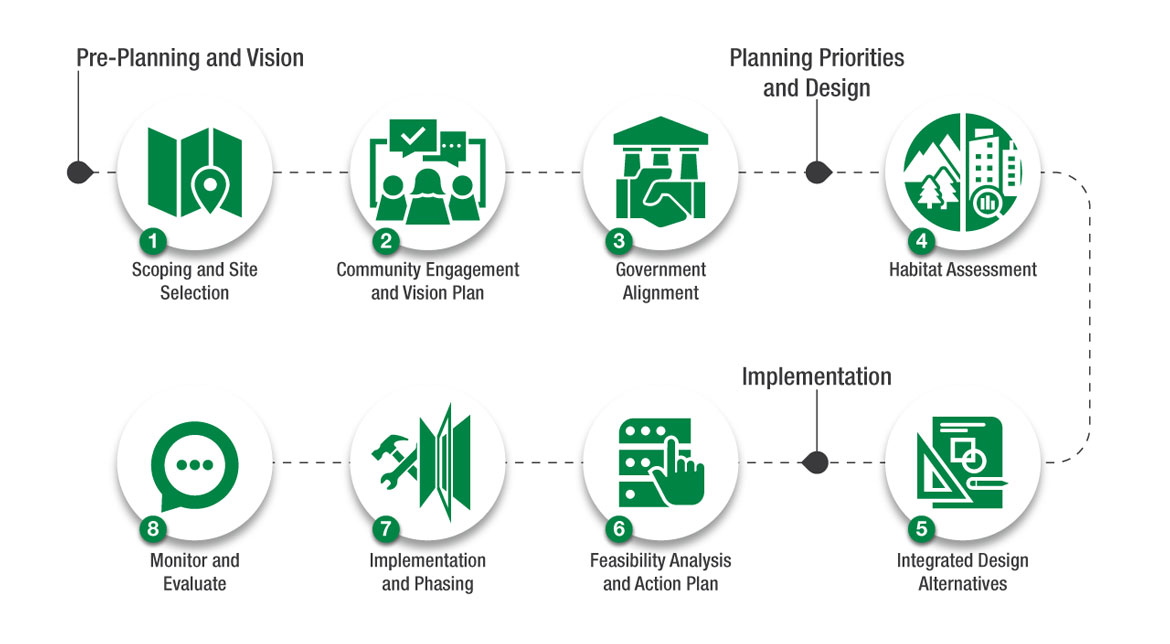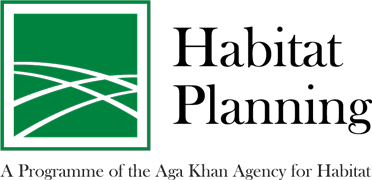3 billion people worldwide could lack adequate housing by 2030 1
Climate change could displace 200 million people by 2050 2
5 billion people could face water scarcity by 2050 3
To address the needs of the time, The Aga Khan Agency for Habitat (AKAH) works to ensure that people live in safe, sustainable, and resilient habitats with the opportunity to thrive, whether in a remote mountain village, a town or a densely populated urban centre.
To mitigate the increasing threats of climate change, natural hazards, and rapid man-made changes, particularly to those living in poverty and fragile areas, AKAH has developed a collaborative, risk-informed approach to land-use planning and design. ‘Habitat Planning’ – empowers people to plan for safety and create resilient homes, neighbourhoods, and communities for future generations. Habitat planning provides a participatory and data-driven framework to guide action from disaster preparedness and response to long-term development.
Habitat planning is an eight-step process that incorporates community-centred participatory design, government engagement, socio-economic and land-use geographic information system (GIS) data analysis, planning, design, and construction. A crucial tool for sustainable and environmentally sensitive rural and urban development, AKAH’s habitat planning framework aims to counter ad-hoc and fragmented physical interventions through long-term spatial design and planning. This approach harnesses the power of planning to drive pluralistic and sustainable growth, support participatory action, and safeguard the future of peri-urban, rural, and mountain communities.

AKAH’s habitat planning principles build upon the 30-year legacy of Aga Khan Rural Support Programme’s (AKRSP) participatory methods and inclusive village governance structures, to support the long-term resilience of vulnerable communities and unlock their social, economic and environmental potential.
Spatial planning has tremendous power. However, it can also control and repress. Untoward, top-down spatial planning can delineate and institutionalise racial and demographic divides, exacerbate inequality and repress civic engagement and exchange. Habitat Planning aims to harness the positive power of planning and to create pluralistic and sustainable regions of growth. To counteract top-down and technocratic approaches, the framework captures two “Habitat Planning Outcomes” and outlines transparent processes and inclusive planning practices that encourage civic engagement and incorporates the vision and voice of the community it serves.
Quality of Life and the Environment
Sound, long-term habitat planning should enhance the quality of life of vulnerable communities by maximising health, safety and economic well-being. Habitat planning empowers communities to choose the right policies, design and planning of land-use, density, housing, public space utilisation and the distribution of key infrastructure and services to improve their quality of life and protect their environment.
Cost, Impact and Organisational Efficiencies
Anticipating the future enables us to be better prepared today. Habitat planning provides information on demographic, economic and land-use trends through its habitat assessment, forecasting and participatory design processes. Using current data and extrapolating trends, habitat planning connects a neighbourhood, village, region or city’s long-term spatial vision to short-term and prioritised actions. The Habitat Plan enhances the efficiency of decision-makers (e.g., community, government, and civil society) by anticipating future challenges and opportunities. This improves alignment, prioritisation and resource allocation towards future goals and spatial designs.
The Habitat Plan provides a unified vision for planning, helping improve coordination and collaboration between local, national and international partners. This facilitates knowledge sharing and project tracking through a shared lexicon, data categories and methods with government bodies, CBOs, donors and implementing partners.
The habitat planning framework offers techniques that can be implemented, iterated and improved upon in the field, and clear planning methods and the development of new data fields based on best practice.
The output of a Habitat Plan aims to blend form and function, ranging from how individuals move in and around their communities, where and how they want to live, to opportunities for increased safety, wellness, recreation, economic growth and livelihoods.

